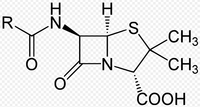








Penicillin is one of the earliest discovered and widely used antibiotic agents, derived from the Penicillium mold. Antibiotics are natural substances that are released by bacteria and fungi into the their environment, as a means of inhibiting other organisms - it is chemical warfare on a microscopic scale.
In 1928, Sir Alexander Fleming observed that colonies of the bacterium Staphylococcus aureus could be destroyed by the mold Penicillium notatum, proving that there was an antibacterial agent there in principle. This principle later lead to medicines that could kill certain types of disease-causing bacteria inside the body.
At the time, however, the importance of Alexander Fleming's discovery was not known.
Use of penicillin did not begin until the 1940s when Howard Florey and Ernst Chain isolated the active ingredient and developed a powdery form of the medicine.
History of Penicillin
Originally noticed by a French medical student, Ernest Duchesne, in 1896. Penicillin was re-discovered by bacteriologist Alexander Fleming working at St. Mary's Hospital in London in 1928. He observed that a plate culture of Staphylococcus had been contaminated by a blue-green mold and that colonies of bacteria adjacent to the mold were being dissolved. Curious, Alexander Fleming grew the mold in a pure culture and found that it produced a substance that killed a number of disease-causing bacteria. Naming the substance penicillin, Dr. Fleming in 1929 published the results of his investigations, noting that his discovery might have therapeutic value if it could be produced in quantity.